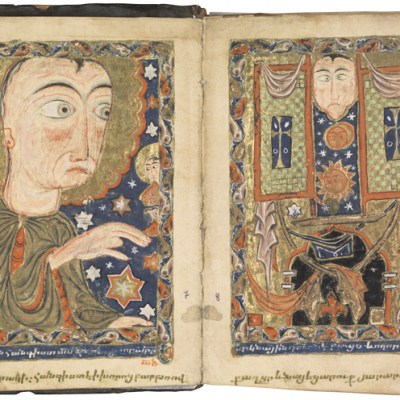On 9 November 2020, Russia, Azerbaijan and Armenia signed an agreement to end war in the region of Nagorno-Karabakh, which began on 27 September. The deal mandated the surrender of several provinces from Armenian to Azerbaijani control during the months of November and December. Alongside the humanitarian crisis caused by the displacement of Armenians, this land transfer also threatens a large number of Armenian monuments located in Karvajar, Kashatagh, Hadrut and Aghdam provinces. The Azerbaijani state-sponsored destruction of the Armenian cemetery in Julfa, Nakhchevan in 1997–2006 and vandalism in the formerly Armenian city of Shushi this past November have set alarming precedents. Heritage organisations including Unesco, the World Monuments Fund and ICOMOS, as well as the Metropolitan Museum of Art, have underlined the urgent need to inventory the monuments and to monitor their condition in the short and long term.
The historical monuments of Karabakh, a mountainous territory in the South Caucasus, collectively testify to the millennia-long Armenian character of the region. While the Hellenistic archaeological site of Tigranakert, the fifth-century tomb at Amaras and basilica of Tzitzernavank, the medieval monastery of Dadivank, and the 19th-century Cathedral of Shushi are most cited in scholarship, they represent only a small fraction of the extant Armenian structures, many of which date to the medieval period. For example, the north-west province of Karvajar alone contains 22 major sites, each of which comprises several monuments and tombstones.
Church at Varazgom, probably built in 10th–11th centuries
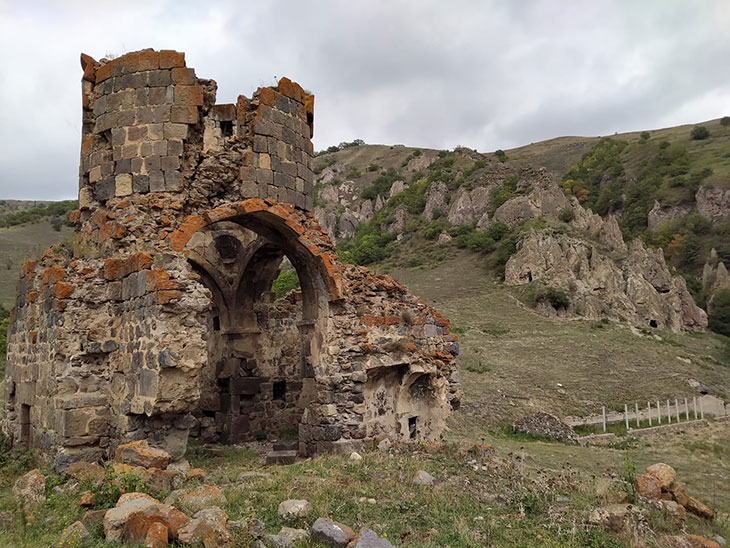
For art historians, this material demonstrates continuities with medieval Armenian culture elsewhere, as well as important regional distinctions deserving of more study, particularly in regard to church planning and structural design. Karabakh has received relatively little attention in the scholarship. Victorian travellers did not go there in great numbers, nor did the German scholar Josef Strzygowski (1862–1941), author of foundational works on Armenian architecture. The Soviet transfer of this region to Azerbaijan in 1921 ensured that, with a few exceptions, the Karabakh monuments were denied the kind of sustained and robust scholarship that monuments in other regions of historical Armenia received.
The ruined church of Varazgom, in the western province of Kashatagh, once formed part of a complex including a cemetery. Varazgom, atypically for Karabakh churches, was domed with a centralised plan. While Varazgom lacks a foundation inscription, scholars situate its architecture and relief sculpture, which includes evangelists’ symbols in the drum, within the building traditions of the 10th and 11th centuries, when this region formed part of Armenian kingdom of Siwnik (987–1170).
The plan of Varazgom is remarkable. Armenian churches usually have a single eastern apse, where the liturgy is performed. Varazgom has two apses: one at the east and another at the north. This asymmetry certainly raises questions about design and structural stability. But it also may reflect a special liturgical requirement. The northern apse may have housed a choir or perhaps a tomb; the space is just large enough for a sarcophagus.
Varazgom is surrounded by fragments of Armenian khachkars, or carved cross-stones. Intended for veneration and connected to the ancient Christian cult of the Cross, khachkars are preserved in great numbers in Karabakh. Some feature simple relief crosses; others boast designs of astonishing complexity, featuring fine interlacing and elaborate geometric patterns. Many khachkars carry inscriptions, including a date, names of sponsors and family members, and pleas for salvation. Khachkars are thus not only aesthetically appealing markers of a general Armenian presence; they function as specific documentary sources that, along with manuscripts, constitute a remarkable resource for reconstructing the history of the region.
Ruins of 13th-century tomb at Chapni. Photo: courtesy Research on Armenian Architecture
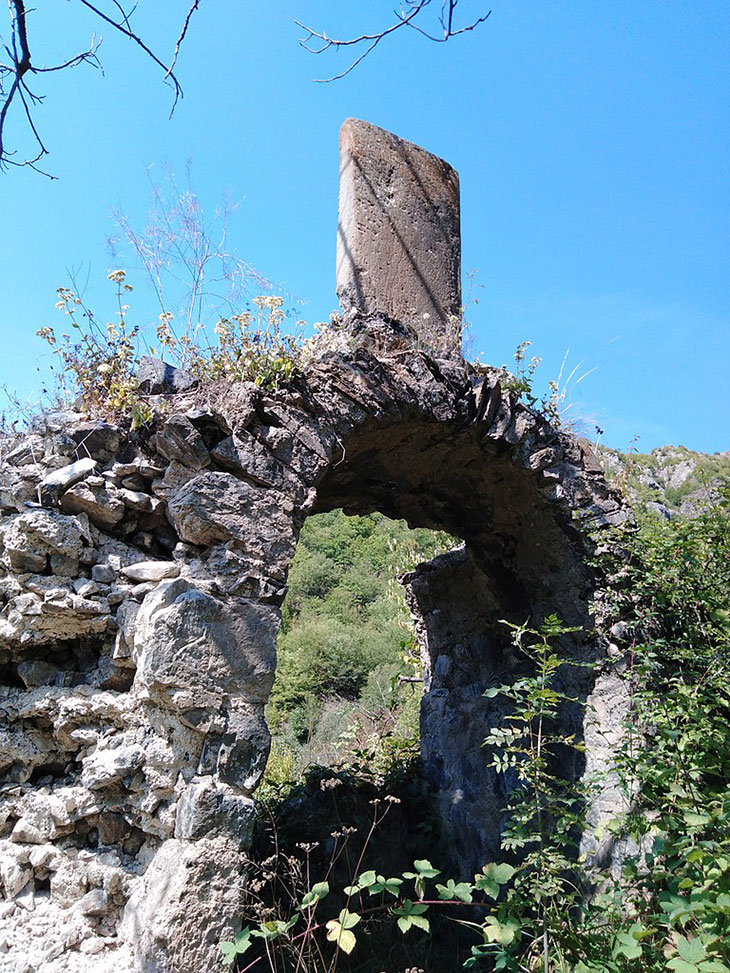
Similarly, a remarkable khachkar stands in the wooded area of Chapni, in the region of Shahumyan, and crowns the ruins of a multi-storey stonemasonry monument, a type known from Armenian funerary architecture. The chapel and second storey suggest spaces for commemoration and prayer in addition to burial. A seven-line inscription appears on the back of the khachkar: ‘Year 1275. By the Will of God, I, Suk’ma and Uka, we erected this cross for our father Ashot and Mother, prayers.’ The height and complexity of this monument suggest that Suk’ma and Uka were members of an elite, demonstrating the survival of artistic patronage through the late 13th century, after the Mongols asserted suzerainty over the region.
Unfortunately, the rich historical legacy of the Armenian monuments of Karabakh has been targeted by vandals who have broken, scraped, and sometimes recycled stones for building. For example, the village of Tzar was once home to a fortress, a vaulted cathedral, churches, cemeteries, and a medieval bridge. Now its largest landmark is a dilapidated school built in the 1950s when the area was controlled by Soviet Azerbaijan. A published plan of the building identifies at least 132 fragments of medieval khachkars, stonemasonry and inscriptions inserted into the walls. The effect is bizarre: visible amid rough-cut stone and mortar are a single arm of a cross, a passage of interlace decoration, a wide-eyed angel, and a few inscribed words. Given the political realities of the Soviet republics, the destruction and reuse of Armenian khachkars clearly had official sanction. The Tzar school ‘taught’, among other subjects, the normalisation of cultural erasure: ‘vae victis’ (woe to the conquered).
Details showing the fragments of medieval stone in the walls of the school built in Tzar in the 1950s, photographed in 1993. Photo: Samvel Karapetian; courtesy Research on Armenian Architecture
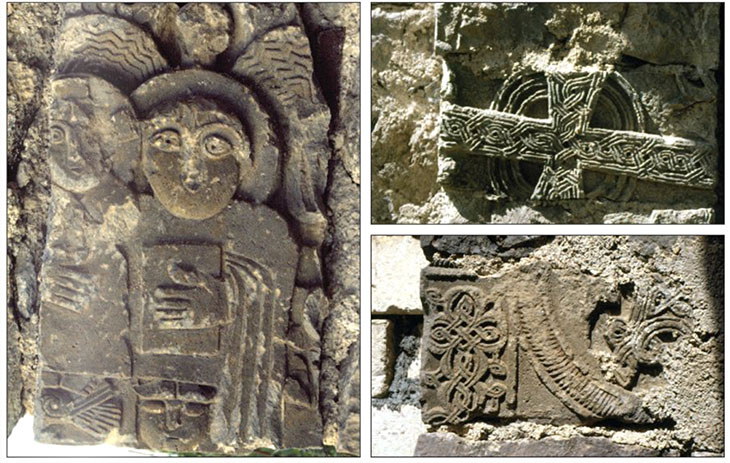
Remains of school built in the 1950s in Tzar. Photo: Joe ‘Hovsep’ Dagdigian
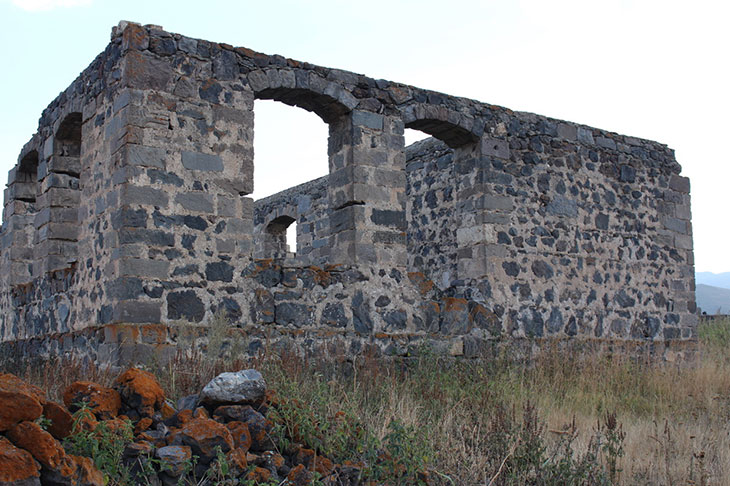
Scholars of social memory may someday study the Tzar school as evidence for attitudes towards a deep past, towards conquerors and conquered, colonised and colonisers. Or perhaps the school will be destroyed, erasing the traces of an earlier violent erasure. Does such erasure face other monuments of the region? For scholars, the question will mean the difference between opening or closing a chapter of the history of Armenian art.
Christina Maranci is the Arthur H. Dadian and Ara T. Oztemel Professor of Armenian Art and Architecture and Chair of the Department of the History of Art and Architecture at Tufts University.

